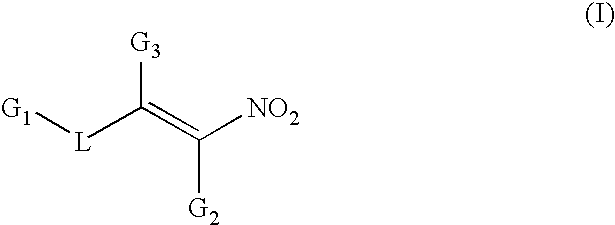Conjugated nitro alkene anticancer agents based on isoprenoid metabolism
a technology of isoprenoid metabolism and nitro alkene, which is applied in the field of conjugated nitro alkene compounds, can solve the problems of complex prenylation of proteins requisite for cancer cell division, and achieve the effect of preventing or reducing the prenylation of cdp
- Summary
- Abstract
- Description
- Claims
- Application Information
AI Technical Summary
Benefits of technology
Problems solved by technology
Method used
Image
Examples
example 1
[0130]The abbreviations used in this example are: Ac2O, acetic anhydride; Ds-GCVLS, the dansyl-labeled pentapeptide N-dimethylaminonaphthalenesulfonyl-Gly-Cys-Val-Leu-Ser; DTT, dithiothreitol; Fmoc, 9-fluorenylmethoxycarbonyl; FTase, human recombinant protein farnesyltransferase; HEPES, N-2-hydroxyethylpiperazine-N′-2-ethanesulfonic acid; PCC, pyridinium chlorochromate; THF, tetrahydrofuran; Tris, tris(hydroxymethyl)aminomethane. 1H NMR spectra were measured at 300 MHz in CDCl3 and chemical shifts (δ) are reported in ppm relative to internal (CH3)4Si or to residual CHCl3 at δ 7.26.
[0131]Preparation of 5,9,13-trimethyl-2-nitrotetradeca-2,8,12-triene (RG-4)—This substance was prepared as summarized in Scheme 1 and as described in detail following the caption:
[0132]
[0133]Farnesal (2). To a stirred solution of 15 g of PCC in 250 mL of dichloromethane was added 10 g of (E,E)-farnesol (1). The reaction mixture was stirred at room temperature overnight and filtered through a 55-cm (height)...
example 2
[0142]Synthesis of 5,9-dimethyl-2-nitrodeca-2,8-diene (RG-14) was by a method analogous to that of 5,9,13-trimethyl-2-nitrotetradeca-2,8,12-triene (RG-4), described in Example 1, as follows:
[0143]5,9-Dimethyl-2-nitrodec-8-en-3-ol (6). Nitroethane (7.5 g) was added to a stirred solution of 13.82 g of citronellal in dichloromethane. Approximately 12-14 g of Amberlyst A-21 ion exchange resin was added, and the mixture was stirred at room temperature overnight. After filtration, the resin was rinsed 4 times with 75 mL of dichloromethane. The filtrate was dried over anhydrous MgSO4 and the solvent was removed by rotary evaporation, affording 20.1 g (95%) of a mixture of stereoisomers of the desired nitro alcohol 6. 1H NMR δ (ppm) 5.2 (t, C═CH), 4.4 (m, CH3CHNO2), 2.5 (broad s, CHOH), 2.0 (br m, ═CHCH2), 1.60 and 1.65 (both s, CH3C(CH3)═), 1.5 (d, CH3CHNO2), 1.2-1.5 (m, CH2CH(CH3)CH2), 0.95 (d, CH2CH(CH3)CH2).
[0144]5,9-Dimethyl-2-nitrodec-8-en-3-yl acetate (7). A flask containing 1.3 g of...
example 3
[0147]Synthesis of 4,8-dimethyl-1-nitronona-1,7-diene (RG-7) was by a method analogous to that of 5,9,13-trimethyl-2-nitrotetradeca-2,8,12-triene (RG-4), described in Example 1.
[0148]Cancer cell growth inhibition. Treatment of human cancer cells grown in culture with 4,8-dimethyl-1-nitronona-1,7-diene (RG-7) at various concentrations resulted in cancer cell growth inhibition, as reported in Table 1.
PUM
| Property | Measurement | Unit |
|---|---|---|
| size | aaaaa | aaaaa |
| electrophilic | aaaaa | aaaaa |
| multidrug resistance | aaaaa | aaaaa |
Abstract
Description
Claims
Application Information
 Login to View More
Login to View More - R&D
- Intellectual Property
- Life Sciences
- Materials
- Tech Scout
- Unparalleled Data Quality
- Higher Quality Content
- 60% Fewer Hallucinations
Browse by: Latest US Patents, China's latest patents, Technical Efficacy Thesaurus, Application Domain, Technology Topic, Popular Technical Reports.
© 2025 PatSnap. All rights reserved.Legal|Privacy policy|Modern Slavery Act Transparency Statement|Sitemap|About US| Contact US: help@patsnap.com



